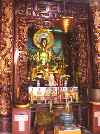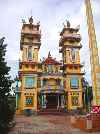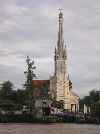|
|
 |
| |
|
| |
 Photo
essay: Photo
essay:
Vietnam Bicycle Tour: Cultural Collage of the South
|
| |
|
Go Cong – Cai Be (70km, 45mi). Cycle
through scenic flat farm land and cross numerous canals.
Points of interest: My Tho, Vinh Tuong Pagoda, Cai Be floating
market. |
|
| |

|
Beyond the influence of its numerous
market centers, the Mekong Delta is very bucolic and rural. |
 |
| |

|
This patch of plants was being
harvested like it was destine for a cut flower market. The buds are still
tights so I was never able to determine for certain what flower it is. |
 |
| |

|
Traveling through the Mekong Delta
by road you cross numerous canals and channels. Most have significant boat
traffic, including barges carrying sand and other building materials, boats
carrying farm produce, fishing boats, house boats, ferries and small boats and
canoes moving up and down and back and forth across the water. |
 |
| |

 |
The Vinh Tuong Pagoda is a bastion
of tranquility in Mytho. Surrounding the temple are shaded gardens and
ponds. The courtyards within the temple is full of bonsai. The
Pagoda is inhabited by a couple dozen monks and novices. The image at
right is the main shine of the temple. The color is distorted from neon
lights used in the ornamentation of the shrine. |
 |
| |

|
The second of the three major
religion in the Mekong Delta region is Catholicism. |
|
| |

“Chang Thang Rach Gam Xoai Mut” monument. |
In January, 1785, the Vietnamese Tay
Son Army defeated thousands of Thai invaders in the battle of “Chang Thang
Rach Gam Xoai Mut”. The secret of the Tay Son's success was “Tay Son Kung
Fu” devised by the national hero Nguyen Hue. Local
warrior Nguyen Hue had assembled all of the best Vietnamese sifu masters along
with Chinese and Thai settlers in Vietnam during a time of great war. He studied
their fighting techniques, and then synthesized and streamlined them into a new,
varied art of combat that suited the strengths of the Vietnamese nation. That
new martial art was named “Tay Son Kung Fu”. Nguyen Hue’s wider goal was
to promote a winning spirit among the Vietnamese fighters that would know no
defeat. He became the first king of the Tay Son Dynasty. |
|
| |

|
The third major religion of the
Mekong Delta is Cao Dia, an indigenous Vietnamese religion. Their temples
can be similar to the Buddhist Pagodas in the area, but often have additional
symbolism drawn from Hinduism, Catholicism and other religions. |
 |
| |
 |
 Cai
Be is a city half on land and half on the river. Business along the river
have docks that handle passengers and goods. On the river is a floating
market. Cai
Be is a city half on land and half on the river. Business along the river
have docks that handle passengers and goods. On the river is a floating
market. |
 |
| |

|

 Floating
produce venders. Floating
produce venders. |
 |
| |
 |


Floating "beverage cart" (coffee included) and floating
"breakfast kiosk".
|
 |
| |

|
The most prominent building in Cai
Be is the Cathedral. Much of the upland area of Cai Be has a lot of trees
and is a very lush and pleasant town. |
|
| |

|

 Glimpse of life along the shore of Cai Be.
Note the customary plastic chairs (left). They are adequately sized for most
Vietnamese but a tad on the small size for most westerners. Glimpse of life along the shore of Cai Be.
Note the customary plastic chairs (left). They are adequately sized for most
Vietnamese but a tad on the small size for most westerners. |
 |
| |
|
| |

 |
|
    |
|
|
 |
 Please
contact us if you would like to be added to
Ibike's mailing list or have questions, comments, corrections or criticism. (Also, please let us know how you learned about us and
found this site.) Privacy policy. Please
contact us if you would like to be added to
Ibike's mailing list or have questions, comments, corrections or criticism. (Also, please let us know how you learned about us and
found this site.) Privacy policy.
 IBF Homepage
IBF Homepage  Ibike Programs
Ibike Programs
 Ibike Schedule
Ibike Schedule
 Search
Search
"Hosted by
DreamHost - earth friendly web hosting"
Created by David Mozer
Copyright ©1993-2022 Ibike LLC. All rights reserved.
|

 Photo
essay:
Photo
essay:  Please
contact us if you would like to be added to
Ibike's mailing list or have questions, comments, corrections or criticism. (Also, please let us know how you learned about us and
found this site.) Privacy policy.
Please
contact us if you would like to be added to
Ibike's mailing list or have questions, comments, corrections or criticism. (Also, please let us know how you learned about us and
found this site.) Privacy policy.![]() IBF Homepage
IBF Homepage ![]() Ibike Programs
Ibike Programs
![]() Ibike Schedule
Ibike Schedule
![]() Search
Search


